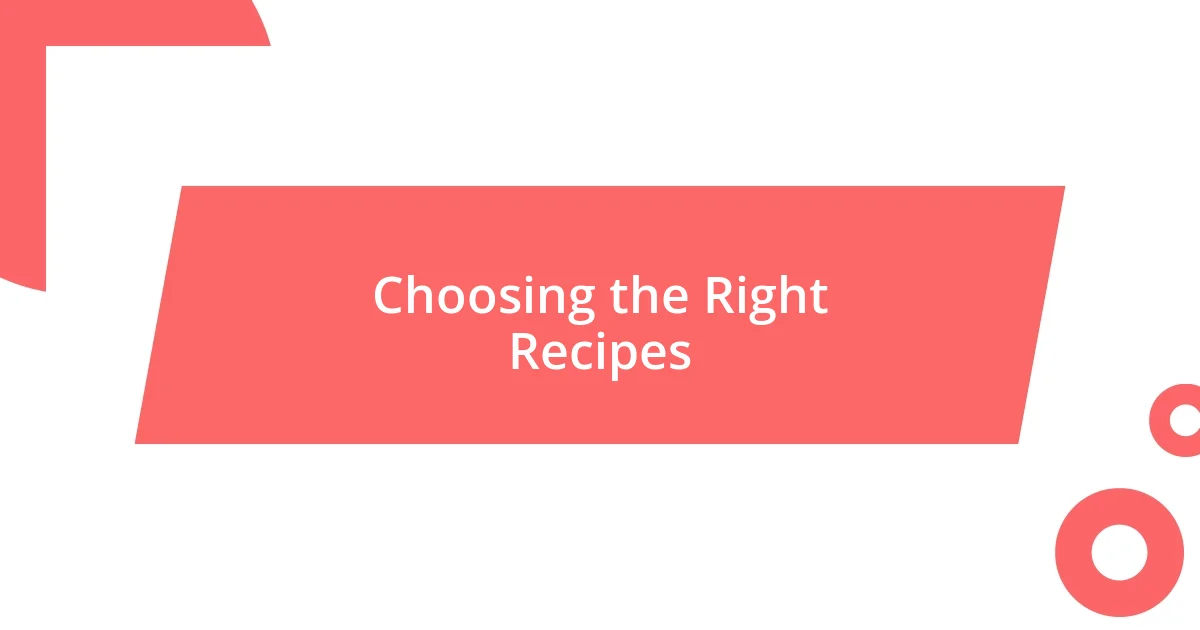Key takeaways:
- Consider seasonal ingredients and guests’ dietary preferences when planning the dinner menu to ensure inclusivity and creativity.
- Engage guests by sharing personal stories related to the meal and using interactive elements like trivia games to enhance the dining experience.
- Effectively handle leftovers by storing them properly, repurposing them into new dishes, and utilizing freezing for convenience and waste reduction.

Planning the Dinner Menu
When it comes to planning the dinner menu, I find that a little brainstorming goes a long way. I often consider the season and the type of gathering I’m hosting. For instance, in fall, I might lean toward comforting dishes like pumpkin soup or hearty casseroles—there’s something about those flavors that warms the soul. Have you ever noticed how certain foods just seem to fit the mood of the season?
I also think about guests’ dietary preferences. I remember a dinner where I learned my dear friend was vegan only after I’d planned a meat-heavy menu. That taught me to ask upfront, even if it feels awkward—I want everyone to feel included at my table. It’s those small gestures that turn an ordinary meal into a memorable experience.
Sometimes, I like to add a surprise element to the menu, like a unique dessert or a themed cocktail. For example, during a summer barbecue, I crafted a refreshing watermelon and mint cocktail that became the highlight of the evening. It’s amazing how a little creativity can elevate the entire gathering—what special touch could you add to your next dinner?

Choosing the Right Recipes
Choosing the right recipes can make or break a dinner party. I often start by focusing on a theme, which helps narrow down my choices. Recently, I hosted an Italian night and was thrilled to serve homemade pasta and a classic tiramisu. It not only set a cozy ambiance but also brought guests together in the kitchen, making for delightful memories.
When selecting recipes, I consider the cooking time and complexity. I remember attempting a three-course meal that required hours of preparation, and by the time guests arrived, I was exhausted! Now, I prioritize quicker, simpler dishes that allow me to enjoy the evening. After all, shouldn’t the host also partake in the fun?
Another key factor is adaptability. I always look for recipes that can be modified to fit my guests’ tastes. One time, I made a chili that was originally loaded with spices. It didn’t take long to realize that one guest preferred milder flavors, so I adjusted it on the fly—adding extra toppings instead. It was a win-win and reminded me how crafting recipes can be a collaborative effort.
| Recipe Type | Adaptability |
|---|---|
| Homemade Pasta | Customizable sauces |
| Chili | Add toppings for different heat levels |

Setting the Perfect Table
Setting the table is an art form that can truly elevate a dinner experience. I take pleasure in selecting tableware that reflects both my personality and the theme of the gathering. For example, when I hosted a casual summer barbecue, I opted for vibrant, mismatched plates that felt relaxed yet playful. Each piece sparked conversation and laughter, creating a warm, inviting atmosphere.
To ensure an engaging table setting, I focus on these essentials:
– Tablecloth or Runner: Sets the mood—opt for bright colors or subtle patterns depending on the occasion.
– Centerpiece: It could be as simple as a vase of fresh flowers or a themed arrangement; this adds charm without overwhelming the table.
– Lighting: Candles are a must! They create a cozy ambiance—I’ve noticed that dim lighting makes everyone more relaxed and chatty.
– Place Settings: I love to mix and match utensils, which adds a personalized touch while keeping it functional.
– Name Cards: A lovely detail for formal dinners; they help guests find their seats and can spark conversation as they discover who they’re dining with.
My approach to table setting is all about creating an enjoyable atmosphere. I remember one dinner where I used fairy lights intertwined with greenery as a centerpiece. The effect was magical! My guests couldn’t stop complimenting the setting, and it truly helped everyone feel at home. A little thought goes a long way in making your table not just functional, but also a visual delight.

Creating a Welcoming Atmosphere
Creating a welcoming atmosphere is all about the little details that make guests feel like they’re somewhere special. For me, the moment they walk through the door, I want them to sense warmth and hospitality. I often choose soft music in the background; it sets a pleasant tone and fills any awkward silences that might surface in the beginning. I remember once hosting a dinner where classical music floated through the air, instantly calming my guests. It sparked such delightful conversations!
Another key element I focus on is lighting. I’ve discovered that a few strategically placed candles can transform even the simplest of spaces. I once hosted a gathering where I lit a few scented candles, and the combination of cozy shadows and a fragrant environment created an almost magical vibe. It wasn’t just about illumination; it was about setting the mood. Don’t you find that when the lighting is just right, it encourages everyone to relax and open up?
Lastly, I make it a point to incorporate personal touches that resonate with my guests. A little photo frame or a quirky item related to a shared joke can act as an excellent icebreaker. On one occasion, I displayed a picture from a previous trip with a friend attending the dinner. It not only sparked laughter but also made everyone feel included in the story. Isn’t it fascinating how these seemingly small gestures can foster deeper connections?

Timing Your Dinner Preparation
When it comes to timing dinner preparation, I’ve learned that a well-structured schedule can make all the difference. I always start by listing the dishes I plan to serve, which helps me gauge the preparation time required for each item. For instance, during a recent dinner, I realized that my beef stew needed hours to simmer, so I got that cooking first, setting a calming rhythm in my kitchen.
I’ve found that organizing my cooking timeline around the dinner service is crucial, especially if I want everything to be fresh and hot. This means prepping the salad while the stew bubbles away, for example, and timing dessert so it’s ready just as we finish the main course. It feels like a delicate dance, and I love flipping between tasks.
The best part is when I step back to see everything come together. I remember feeling a sense of accomplishment when I pulled that stew off the stove just as my guests arrived, filling the house with savory aromas. It’s a wonderful feeling to watch everyone enjoy the meal, knowing the timing was just right. How do you time your meals to create that perfect blend of flavors and warmth?

Engaging Guests During Dinner
Engaging guests during dinner is crucial to creating a lively atmosphere. I often facilitate this by introducing a fun and interactive element, like a themed trivia game related to the food we’re enjoying. One time, I prepared a Mediterranean feast and shared interesting facts about the dishes while encouraging my guests to guess their origins. I could see the excitement in their eyes as they participated, laughing and sparking conversations about their own travel experiences. Isn’t it amazing how food can transport us to different places?
Another technique I employ revolves around sharing stories and experiences tied to the meal. During a dinner where I served my grandmother’s famous lasagna, I took a moment to recount how she taught me the recipe. My guests not only enjoyed the dish more knowing its background, but they also started sharing their own family recipes, creating a delightful exchange. I truly believe that these personal narrations can transform a meal into a memorable experience that lingers long after the last bite is taken.
Finally, I pay close attention to group dynamics and ensure everyone feels included in the conversation. If I notice someone is quieter, I make a point to direct a question their way or ask for their opinion on the dishes being served. In one instance, I noticed a friend wasn’t as engaged, so I asked about their favorite cuisine. It turned out they had fascinating stories from their travels in Asia! By gently nudging certain guests to share, I leveled the playing field and fostered an atmosphere where everyone felt valued and heard. Don’t you think that everyone deserves a chance to shine at the table?

Handling Leftovers Effectively
One of my best practices for handling leftovers is to store them in clear, labeled containers. I remember a time when I packed away a delicious homemade curry and completely forgot about it until weeks later! The vibrant color of the container made it easy to identify, and labeling it helped me remember its contents. This simple trick not only saves food but also keeps my fridge organized—who doesn’t love that?
I’ve also found that repurposing leftovers can be a fun culinary challenge. Just the other night, I transformed my extra roast chicken into a savory chicken salad for lunch the next day. Tossing in some crunchy apples and nuts created a delightful contrast, and it felt rewarding to make something new from what could have been waste. Have you ever experimented with your leftovers? It can be surprisingly satisfying to reimagine a dish and discover new flavors!
Finally, I’m a big advocate for freezing leftovers. I can’t count the times I’ve been grateful for a home-cooked meal on a busy evening because I took the time to freeze portions. Last month, after a gathering with friends, I froze an extra batch of chili. When I pulled it out weeks later, it felt like a cozy hug on a cold day—perfect for a quick dinner. Isn’t it comforting to know you have a delicious meal waiting for you when you need it most?















